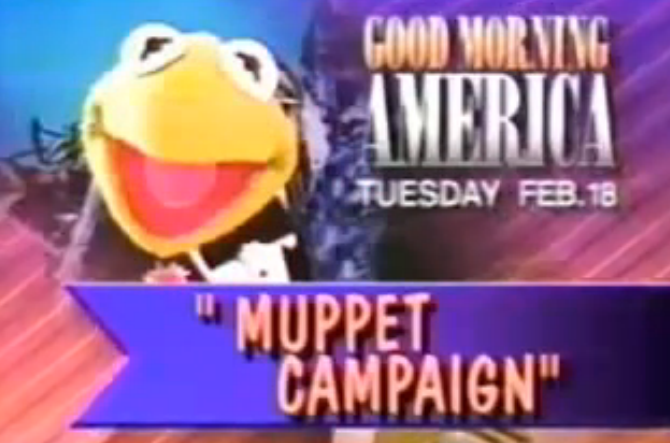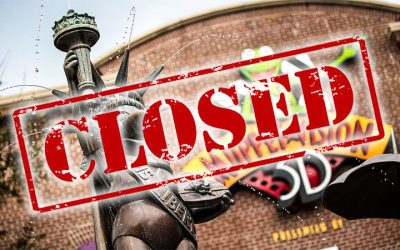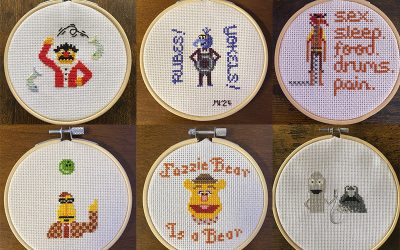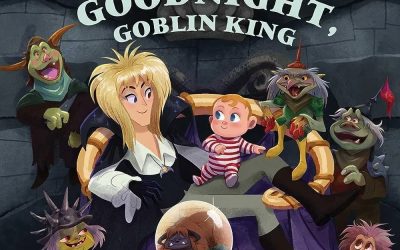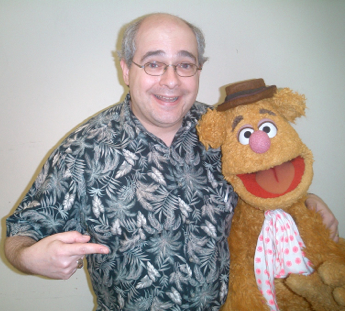
Craig Shemin (L) with Fozzie Bear (R) © Muppets Studio
Craig Shemin has been writing for Muppets for decades, on such wide-ranging projects as the Muppets Inside CD-ROM, the Muppets Kitchen with Cat Cora web series, and The Wubbulous World of Dr. Seuss. He’s also the president of the Jim Henson Legacy, and he’s hosted countless screenings of Henson material at various venues. Recently, he wrote The Muppets Character Encyclopedia, which was published in February and which you should own by now. To mark the occasion of the book’s release, Craig sat down with us for some Q&A.
Tough Pigs: Craig, thank you so much for finally sitting down with us for an interview.
Craig Shemin: I’ve been here all the time! I’ve come into this office every day, just waiting for you to show up.
TP: We got on the wrong bus. So, you have been, of anyone at the Henson Company, one of the best friends to the Muppet fans, which has been very nice for us.
CS: I think one of the reasons is that I consider myself a Muppet fan. I was a Muppet fan before I worked for the company. I was ten when The Muppet Show first came on the air, so I remember watching it every week, and I grew up with Sesame Street. Around the time of The Muppet Show, I would go to the library and do research and print out microfilm articles from Time magazine, when I was around thirteen or fourteen. So I look at things through the eyes of a fan, but it’s challenging to also have to be in the world of reality, where there are others involved in the process that are not necessarily looking at it through the eyes of a fan.
TP: Which is a shame, for us.
CS: Right. But there are more people coming at it from my point of view now. When you look at the people who made the new movies happen, they came in as Muppet fans. You can tell with the depth of characters that they pull from. They’re not necessarily looking at it from, “What character can we use that is going to sell better?” They’re not saying, “Oh, let’s bring Annie Sue in here because we need to sell Annie Sue toys.” Although you never know, that could be popular…
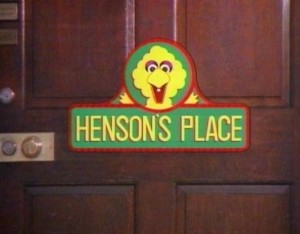 TP: Can you tell us how you got started with Jim Henson and the Muppets after just being a fan, passing that threshold to working for the company?
TP: Can you tell us how you got started with Jim Henson and the Muppets after just being a fan, passing that threshold to working for the company?
CS: I began as an intern. I was in college at Northwestern University, and during my junior year I was sitting around the dorm, and the PBS station was showing Henson’s Place. This would have been in 1987, so Henson’s Place was still a relatively new show at that point. I had seen some of the other things, like Of Muppets and Men, because they showed that in the Muppet Show time slot when the show was in syndication, when I was younger.
I had my one VHS tape, because that’s when they cost like $18 apiece. I taped The Muppet Show every day, only keeping the episodes I really liked because I had just the one tape (maybe two). One day, they actually showed the (Michael) Parkinson interview with the Muppets, and when we show clips now [at Henson screenings], some of that it comes from that very VHS tape that I had, because it was not part of the Henson library.
TP: That was all shown in the Muppet Show time slot?
CS: Yes, they had Parkinson interviewing the Muppets. And they had Of Muppets and Men. Anyway, back to the college story… I’m in my dorm and Henson’s Place is on. So I watched it, and at that time I was trying to figure out what to do with my summer. Being a big Muppet fan, I wondered if they had internships. The next day, I called information and got the number for Henson Associates, and I called up and talked to some people and they scheduled an interview for me to come in and talk to them when I was on Spring Break.
I met with a few people. One of them was Susan Berry, who was then the head of Public Relations. She offered me an internship for that summer of ’87, and that’s when I began my relationship with the Henson organization. That was the summer I first met Jim. I did a lot of grunt work, and I also did some interesting things, and fun stuff.
I worked on the company chronology – that was the company history that was sort of an adapted and abridged version of Jim’s “Red Book.” At the end of the summer, Jane Henson asked to meet with me (she had heard that I was doing work on the chronology). She gave me some wonderful advice and at the end of the meeting she said, “I don’t have any authority to offer you a job, but I hope that when you graduate you’ll be able to come back to us.”
I stayed in touch with Susan, and during my breaks I would come in and she gave me some temp work, because it always seemed like she was firing an assistant, every time I came back.
Then I was hired to be the PR Assistant/Archivist when I graduated. I was excited about that, but then I found out in reality the job had a lot more of PR Assistant than Archivist, so I didn’t get to do as much with the archives as I would have liked. My job at the archives basically became about making sure people didn’t throw things away, and trying to gather stuff. It wasn’t until Karen [Falk] came in that she was able to put things in a real order. I started a little bit of a catalog, and I said, “Let’s get acid-free materials, and let’s start taking care of things,” but I just didn’t have the time to do as much as I hoped I would be doing. I was busy answering the phones and such. So that’s sort of how I came into it.
TP: How did you transition into writing from that?
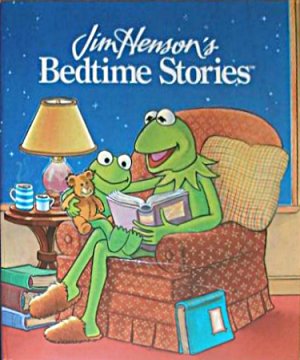 CS: I was a really bad assistant. There were parts of it that I did very well. I have a good telephone voice, so I could answer the phone, but there were things I just didn’t do well, like deal with petty cash and filling out accounting forms and stuff like that. The whole company was a little lackadaisical back then. This was before we had people who were MBAs come in and teach us how to run a company.
CS: I was a really bad assistant. There were parts of it that I did very well. I have a good telephone voice, so I could answer the phone, but there were things I just didn’t do well, like deal with petty cash and filling out accounting forms and stuff like that. The whole company was a little lackadaisical back then. This was before we had people who were MBAs come in and teach us how to run a company.
At the same time that I was being not a very good assistant, they knew that I had an interest in writing. I was being given opportunities to write some of the character interviews in the newspaper, and I started writing some stories for the Bedtime Stories series for Publishing. Eventually the PR department expanded, and they were bringing in another assistant, which allowed me to be sort of a full-time PR writer. I was writing all the press releases, and the show synopses, and character interviews.
I was in the PR department for about three years, and then Bill Prady, who was then working out of the LA office, was leaving the company. He had a deal with Disney. Henson decided to move Jim Lewis out to LA, and then Charlie Rivkin talked to me about taking over Jim Lewis’s job. I was given a trial period, and then assumed that role after six months, on a permanent basis.
TP: Do you remember the first thing you wrote for the Muppets?
CS: I don’t remember exactly what it was. Probably a character interview. One of the early things I did was an interview in the Chicago Tribune magazine. There was a section where they would always have a celebrity with a big picture and they would have a Q&A. To do this, they would send a questionnaire. Now, the Q&A is only ten or fifteen questions, but to get good answers they would send a list of fifty or sixty questions. And you know, you send that to Frank Oz and he’s just going to rip it up into little pieces. So that was one of the early things — I wrote Piggy’s responses to that, and I sent it to Frank and he scribbled in some things and faxed it back (we used fax machines back then). I think I still have the Xerox with his notes on it.
I do remember the first thing I wrote for the Muppets that got performed, and it was actually performed by Jim Henson. It was Kermit’s address to the Disney shareholders when the Disney deal was first going to happen in 1989. It was just one of these weird things. PR was dealing with the Corporate Communications department at Disney, which was handling the whole shareholder meeting.
Susan had me write a draft of it, and it went to Jim Henson, and Jim said, “Well, let’s have Bill Prady take a pass at it,” so Bill did an entirely different draft. Then Jim said, “That’s good; send it to Disney,” and Disney didn’t like it. Then I think they had Jim Lewis do a draft, and neither of them thought it was right. Basically, it came back to me: “Start with Craig’s draft, and have him put in stuff from Jim and Bill’s drafts,” and then I put together my version of it using bits from the others. Then everybody seemed to be satisfied.
I have the VHS tape at home. It was in the studio [at the Henson Carriage House]. Jim had Kermit up, and had me reading the Michael Eisner responses. Kermit was going to be talking to Michael Eisner. You can hear my nervous, little 23-year-old voice: “Yeah, Kermit, it’s great that you’re part of the Disney family!”
TP: So he performed Kermit and you performed Michael Eisner.
CS: Yes. Only my part was taken out in post-production. It was fun, and afterwards they did a write-up about it in the Hollywood Reporter, and Jim sent around a little note thanking me and Bill and Jim for working on it.
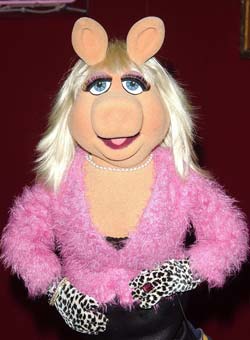 TP: How hard is it, or intimidating, when you’re writing for a character like that, that’s been originated by other writers and performers? Especially when you’re working with the performers.
TP: How hard is it, or intimidating, when you’re writing for a character like that, that’s been originated by other writers and performers? Especially when you’re working with the performers.
CS: It’s very intimidating. There are certain characters that are harder than others. I very rarely have problems doing Piggy. Frank would tear things apart and put them back together, but it was always about finding the true pig. Each of the performers comes to it with a different point of view. It was always a challenge, but everybody was always in it to try and make it the best that we could.
One of my advantages is that I had seen all the stuff. I think some of the writers that were a little bit older than me were not necessarily as familiar with some of the material. They had been writing it longer — Jim and Bill had been doing it longer — but they don’t necessarily have the same knowledge of watching it. When I was an intern, I would take tapes off the shelf in the conference room and watch The Muppet Show during lunch.
And of course you’re working with Jerry Juhl, who was there, and that was just a blast. We did the Good Morning America segments together, the Muppet Moments.
CS: It would have been about ’92 or ’93, after Jim died. It was me, Jim Lewis, and Jerry Juhl who wrote those, and I was so excited to be getting that opportunity because I had just transitioned out of Public Relations and hit the ground running. I think I was doing that and Muppet Meeting Films around the same time.
I wrote up some scripts and gave them to Jerry as he was just leaving to take a plane back to California. He grabbed the scripts, he said goodbye, and then about a half hour later I get a call from the airport: “Craig, it’s Jerry. I read your scripts.” And I’m like, “You were gone a half hour!” And he’s like, “Yeah, I gotta tell you, you write really great radio.” That was his way of telling me that I wasn’t being visual enough. That always stays in my mind. Every time I end up writing anything for Muppets now, or anything for television, always keeping that in mind: Am I being visual enough? Frank would always say, “Do you need puppets to do this?”
Jerry taught me so much. The whole idea of “It’s easier for a puppet to grow a second head than it is for him to answer the telephone.” That was one of his precepts: If you don’t need to show them picking up the phone, don’t show them picking up the phone, because you gotta stop tape. So working on that alone was very educational.
I would always send stuff to him for feedback. He was not really part of the everyday process by that time. He would come in and work on projects and work on the movies. Every so often, we would end up working on stuff together, like if I was doing the Muppet Treasure Island CD-ROM or something, where I needed to interface with what he and Kirk [Thatcher] were doing.
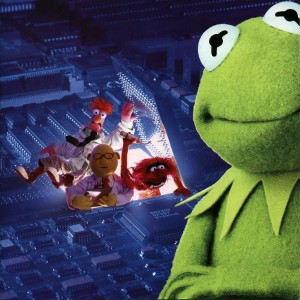 TP: Writing for the Muppets in the ’90s, you probably had a lot of opportunities to write for what was at the time a new medium, or just kind of testing something out and throwing it out there. Can you talk a little bit about those challenges, of being given a project and you kind of have to run with it with no previous experience?
TP: Writing for the Muppets in the ’90s, you probably had a lot of opportunities to write for what was at the time a new medium, or just kind of testing something out and throwing it out there. Can you talk a little bit about those challenges, of being given a project and you kind of have to run with it with no previous experience?
CS: I loved those projects, because no one else understood them. I didn’t understand them, but no one else around me understood them either. I did the Muppet CD-ROM first, before I did the Treasure Island one. The award-winning Muppets Inside, for the state-of-the-art Windows 95! We’re all sitting around at the meeting, and the Starwave people say, “You know, we’re doing this expressly for Windows 95, so if you don’t have Windows 95 you can’t play the game.” All of us in the office are sitting around with our old Windows 3.1 computers, and we’re like, “Do you think that’s a good idea? Is anybody actually going to get Windows 95?” They were like, “We’re pretty confident. It’ll be in all the new computers being sold.” So we’re like, “Okay! If you say so.”
I think the script for that was 120-some-odd pages, and the way you write it, it’s all non-linear. You’re doing each game, each sequence at a time. I think I did everything on that, except the questions and answers for the Hollywood Squares game. Another writer, Steve Morgenstern, did them.
At the time, I answered to Michael Frith. He was Head of Creative Services. My title at the time was Associate Creative Director. That was Jim Lewis’s title, so when he went to LA, that’s the title I got. I handed the script to Michael to look at, and he was puzzled by it. He wrote on it, “I guess it’s all right, but I don’t understand… There’s an ending on page 11, and then it goes on for another hundred pages.” I tried to explain it to him. “Well, that’s the ending, but this is all of the other branching possibilities.” He’s like, “Oh. Whatever you say.”
So in some ways I got to have a lot more freedom in that project, because there weren’t a lot of other people at Henson who understood what we were doing. John Cutter, who was the producer at Starwave, and I really got to mold that project, and turn it into what it became. It was just a blast.
They had the press event to launch it at the townhouse, and Charlie Rivkin, who was the head of the company at the time — who has since served as ambassador to France — Charlie was emceeing this big press event, and it was the first Jim Henson Interactive project, so there was a lot of buzz.
Charlie had no idea that at the beginning of the game, it crashes. No one told him. So he starts the game, and — [imitates computer stuttering sound]. Charlie’s looking at us — and then it started. But for a second it looked like he was going to tear us apart. Like, “This is the worst possible moment that we could have a failure, guys!” Then everything proceeded and he relaxed, but looking back, we probably should have told him.
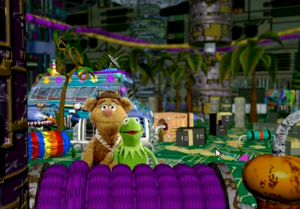 TP: That probably fooled a lot of people.
TP: That probably fooled a lot of people.
CS: Yeah, it did. I don’t have a computer I can play it on anymore, but people have posted game-play video on YouTube, and it’s still fun to watch. The one thing that was sad about it was that I didn’t get to go out for the shoot. They did it in London, because it was at the same time that they were making Treasure Island. They had a video stage set up across the street from the soundstage, so whenever people weren’t working on the movie, they would come over and shoot the stuff for both of the games, Treasure Island and the Muppets CD-ROM.
For that week, I was on a schedule in case they needed to get me on the phone. I was living the London hours in New York. I’d be up all night on the phone, talking to them. There are still some things when I watch it, I’m like, “Oh, I wish I could have told Dave Goelz to deliver a line differently!” He didn’t quite get what we were going for when there was a Wizard of Oz homage where he says, “I can’t come back, I don’t know how it works!”
But everything on that project was great. The music — we had fun doing the things with Beaker, Animal, and the Swedish Chef. It was one of the few times that I had to have my material approved by Legal for creative purposes. We did the copyright notices, those musical pieces: (Sings to the tune of “Roll Out the Barrel”) “Roll out the notice/The copyright notice is here!” (To the tune of “Toreador Song”) “Jim Henson’s Muppets, and all their names/Are trademarks, of course…” Those had to be approved by Peter Schube.
I still have an envelope with four quarters in it… I wrote the new lyrics for the Muppet Show theme, and I had to sign over my rights to those because I didn’t write the original. They sent me a release to sign, in exchange for one dollar. I signed the thing, and I sent it back and said, “Well, here’s the release. Where’s my dollar?” Schube sent back four quarters in an inter-office envelope. I think I still have those four quarters somewhere.
TP: You also wrote the MuppeToons that were on the old Muppets.com?
CS: You know, that’s one thing that I’m not sure the wiki is right about. I may have written some stuff that ended up being used. I did work on a lot of the Muppets.com and Henson.com stuff.
One of my favorite things was doing “Ask Dr. Honeydew” on that. I was trying to get Disney to turn that into a going concern, and maybe do a book about Muppet Labs. I think there was a “Dear Miss Piggy” column, and I did some of that. I don’t really remember what the MuppeToons looked like.
TP: They were like CGI Muppets. They might have been digital puppetry?
CS: I think Jim Lewis was doing that. I was doing The Wubbulous World of Dr. Seuss here for a while, and that kept me busy. But I don’t have a recollection. I cannot confirm or deny.
Come back soon for part 2, in which Craig talks about hosting clip compilations, keeping the Muppets in character, and Miss Piggy’s ears! Click here to watch The Muppet Show during lunch on the Tough Pigs forum!
by Ryan Roe – Ryan@ToughPigs.com

